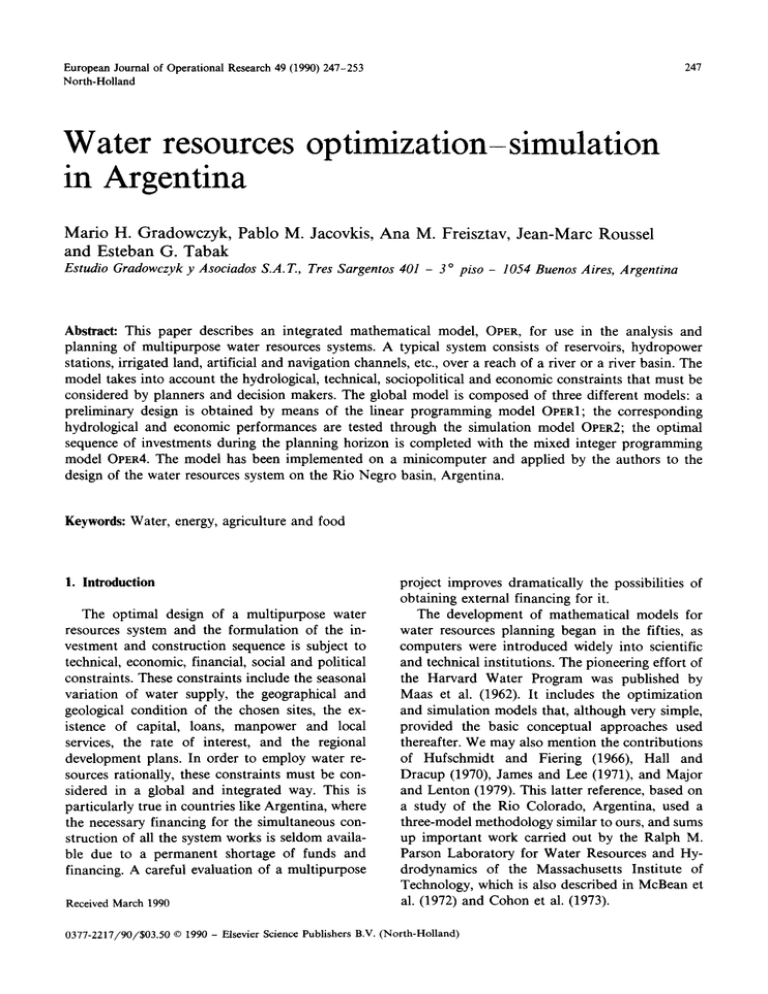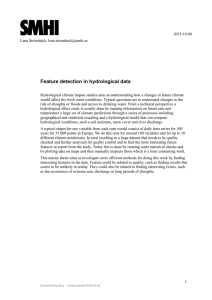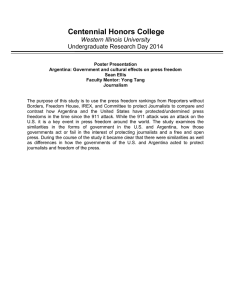Water resources optimization- simulation in Argentina
advertisement

European Journal of Operational Research49 (1990) 247-253 North-Holland 247 Water resources optimization- simulation in Argentina Mario H. Gradowczyk, Pablo M. Jacovkis, Ana M. Freisztav, Jean-Marc Roussel and Esteban G. Tabak Estudio Gradowczyk y Asociados S.A.T., Tres Sargentos 401 - 3 o piso - 1054 Buenos Aires, Argentina Abstract: This paper describes an integrated mathematical model, OPER, for use in the analysis and planning of multipurpose water resources systems. A typical system consists of reservoirs, hydropower stations, irrigated land, artificial and navigation channels, etc., over a reach of a river or a river basin. The model takes into account the hydrological, technical, sociopolitical and economic constraints that must be considered by planners and decision makers. The global model is composed of three different models: a preliminary design is obtained by means of the linear programming model OPER1; the corresponding hydrological and economic performances are tested through the simulation model OPER2; the optimal sequence of investments during the planning horizon is completed with the mixed integer programming model OPER4. The model has been implemented on a minicomputer and applied by the authors to the design of the water resources system on the Rio Negro basin, Argentina. Keywords: Water, energy, agriculture and food 1. Introduction The optimal design of a multipurpose water resources system and the formulation of the investment and construction sequence is subject to technical, economic, financial, social and political constraints. These constraints include the seasonal variation of water supply, the geographical and geological condition of the chosen sites, the existence of capital, loans, manpower and local services, the rate of interest, and the regional development plans. In order to employ water resources rationally, these constraints must be considered in a global and integrated way. This is particularly true in countries like Argentina, where the necessary financing for the simultaneous construction of all the system works is seldom available due to a permanent shortage of funds and financing. A careful evaluation of a multipurpose Received March 1990 project improves dramatically the possibilities of obtaining external financing for it. The development of mathematical models for water resources planning began in the fifties, as computers were introduced widely into scientific and technical institutions. The pioneering effort of the Harvard Water Program was published by Maas et al. (1962). It includes the optimization and simulation models that, although very simple, provided the basic conceptual approaches used thereafter. We may also mention the contributions of Hufschmidt and Fiering (1966), Hall and Dracup (1970), James and Lee (1971), and Major and Lenton (1979). This latter reference, based on a study of the Rio Colorado, Argentina, used a three-model methodology similar to ours, and sums up important work carried out by the Ralph M. Parson Laboratory for Water Resources and Hydrodynamics of the Massachusetts Institute of Technology, which is also described in McBean et al. (1972) and Cohon et al. (1973). 0377-2217/90/$03.50 © 1990 - ElsevierSciencePublishers B.V.(North-Holland) 248 M.H. Gradowczyk et al. / Water resources optimization in Argentina A long tradition in water resources models exists in Argentina, which began with a simulation model of Andean rivers prepared by a multidisciplinary staff at the University of Buenos Aires and (what is important in a developing country) the model was used by the client, the Economic Comission for Latin America (see Arhoz and Varsavsky, 1965). The continual political instability in Argentina damaged research in water resources system planning at that time (and all other research programs). However, the research tradition has survived and is at present (when it is not possible, around the world, to ignore the use of computer mathematical models in water resources systems planning) alive and well. Continuing in this tradition, the integrated water resources model OVER was developed, programmed, implemented, tested and commercially applied in Argentina; the optimization and simulation software was also prepared by us and not bought or rented. OPER is currently an operational product software, and has been used in the design of the water resources system projected for the Rio Negro basin. Cost and benefit data 2. General description of the model A general scheme of the integrated model OPER is shown in Figure 1. The three models OPERI, OVER2 and OPER4 may run in an integrated fashion or separately. The preliminary optimized design of the water resources system is obtained using the linear programming (LP) model OPERI. The concept 'preliminary design' implies the computation of the major characteristics of the works: water head of the dams, installed capacity of the power plants, irrigation areas, geometry of excavated channels, etc. In this procedure some linearizations are introduced in the model equations and data to fit the available computer capabilities. This preliminary design is then tested by the simulation model OVER2, which verifies the hydraulic and economic performance of the system using long records of historical or randomly generated boundary conditions, i.e., discharges, with a monthly time step. Finally, as not all investments are possible at the same time, the mixed integer Physical, economic and sociopolitical constraints Financial constraints ! i I I I I Seasonal hydrological data "-9 OPER I OPER 4 --9 LP optimization design model MIP sequencing optimization model i i Monthly hydrological synthetic and/or historical data Optimal preliminary design Optlmal sequence of works i .t I Monthly operational rules K ~ t OPER 2 Simulation model for operation through long periods -t I Evaluation of simulated design Figure 1. General scheme of the integrated model OPER M.H. Gradowczyk et al. / Water resources optimization in Argentina programming (MIP) model OPER4 computes the optimal schedule of construction of the different works with the designs obtained by means of the other models. 3. The LP model OPER1 The model OPER1 computes the optimal design of a multipurpose water resources system projected in a river basin and consisting of reservoirs, hydroelectrical stations, irrigation lands, urban water supply, artificial channels, navigation channels, etc. 'Optimal design' means the design that maximizes an economic function, i.e. the total discounted net benefit (net present worth) during the planning horizon (25 years or more). The constraints of the model are produced by the operation rules, the continuity equation of water, and the physical and economic characteristics of the system. The following conditions are also assumed: (a) The design will be optimal for the 'mean hydrological year'. (b) During the planning horizon, benefits will be obtained once the construction of the corresponding work has finished. Construction of all works begins at the base year, or later. The model considers that the water resources system replicates during the planning horizon a 'mean hydrological year' divided into M periods, not necessarily equal, defined for hydrological, agricultural a n d / o r commercial reasons. The water resources system is composed of a main river, its tributaries and its effluents. Both the tributaries and effluents (or part of both) may be artificial channels. The system is discretized in nodes. Each node corresponds to a reservoir, a hydroelectrical station, an irrigation intake, a junction point of a tributary or effluent and the main river, a multiple situation, etc. Mean upstream discharges for all periods are input data and are routed downstream considering continuity equations at the nodes, infiltrations between consecutive nodes, evaporation in reservoirs, lateral inflow and outflow at nodes, etc., according to the projected works. Ratios of infiltration and evaporation and lateral inflows and outflows not specifically considered as variables are also input data. The constraints of the LP model are: 249 (a) Continuity constraints at all nodes: variation of storage in a reservoir in period t equals the sum of inflows minus the sum of outflows. (b) Reservoir constraints: each reservoir has a maximum storage capacity bounded by topographic, hydraulic, geologic or economic conditions of its site. (c) Irrigation constraints: each irrigable area has a physical or economic bound; on the other hand, for, say, political reasons, a minimum area under irrigation may be guaranteed. The irrigated land is the same for all periods, but the daily amount of irrigation water per hectare changes according to the periods. Part of the water diverted for irrigation may return to the stream at a later period. (d) Hydroelectrical constraints: these are the technical constraints involving energy and power and the hydrological constraints involving energy, turbinated discharge and net head of dam: the energy produced at a site during a period is bounded by the power plant capacity times the number of hours of the period, and is proportional to the turbinated discharge and to the net head. The hydrological constraints are nonlinear, and we have applied the iterative linearized method proposed by Major and Lenton (1979), which converged in all our experiments in at most three runs. (e) Upper bounds for installed power and head are needed at each power plant. The head may be increased with an excavated channel below the dam, and may be perturbed by the backwater produced by a power plant downstream. Firm power is also modelled, since it is an unknown that influences the economic viability of a power plant. (f) Other constraints are related to the minimum discharge needed for navigation and the cost of artificial channels. It is supposed that they depend on the discharge flowing through them. The objective function is the algebraic sum of the present value of net benefits, i.e. the net present worth (NPW) of the works with their optimal designs. During the planning horizon, annual incomes are due to energy sold and firm power guaranteed, and to the increased agricultural productivity due to irrigation. Costs are linearized as are, for all reservoirs, the usually nonlinear one-toone relationships between the stored volume of water at each period and the corresponding elevation of water. But, as Hadley (1964) points out, 250 M.H. Gradowczyk et aL / Water resources optimization in Argentina care must be taken when implementing piecewise linear algorithms because the optimum found may be a local optimum if nonlinear constraints and the objective function do not have the necessary convexity/concavity properties; and they do not have them in this model. In addition, the introduction of tables with many pairs of elements increases dramatically the size of the LP, so that a trade-off is necessary between using the piecewise linear algorithm and performing several runs with linear relationships. The NPW method was used because of its linearity, and was accepted by the client: the National Agency for Irrigation and Hydropower Agua y Energia El~ctrica S.E. The model also prints results of other discounted measures of project worth not used in the optimization because they are nonlinear: benefit-cost ratio (extensively used for water resources projects) and net benefit-investment (N/K) ratio (see, for instance, Gittinger (1982), where these different discounted measures are carefully discussed). 4. The simulation model OPER2 Model OPER2 simulates the hydraulic and economic performance of the multipurpose system during long periods (20 to 50 years)with a monthly time step. The model accepts a general arborescent fluvial network similar to that used with model OPERI. It considers that construction can take place at any specified time during the simulation period (which coincides with the planning horizon of the LP model); each construction changes the system's hydrology. Several alternative policies may be applied, for example to maintain the maximum head of a reservoir during certain months, and the minimum head during others; or to turbinate only after water demand has been satisfied. The remaining water is sent through spillways when the power capacity is exceeded. Flood control and navigation must also be taken into account. The policies may also be global, i.e. they establish how different reservoirs will solve a possible urban water or irrigation shortage. When an operating policy is infeasible, it may be dynamically changed. Continuity equations are employed to route the flow downstream; infiltration and evaporation losses are considered, as is also sedimen- tation in dams (it causes height/volume functions to change dynamically during the simulation). Stored volumes of water in each reservoir have lower and upper bounds, and, generally, basic equations are similar to the constraints of the LP model, with detailed operational rules. The model OPER2 is extremely flexible; a water resources system may be simulated where some requirements are not satisfied. There may be shortages of urban water demand, or of irrigation, or of firm power, or of energy, and they may be included with a penalization in the economic performance function. This economic performance function is, in a sense, analogous to the objective function of the LP model OPER1, but no linearization of cost functions is needed, and costs and benefits are computed monthly. Hydrological behaviour is also measured monthly, and annual and partially accumulated economic and hydrological statistics are displayed. The main designed parameters computed by model OPERi (capacity of reservoirs, irrigation areas, installed power in hydropower plants, depths of excavated channels, maximum admissible discharges through artifical channels, etc.) are inputs to model OPER2. This can be run using the results obtained by model OPER] or independently. 5. The M I P model OPER4 Model OPER1 selects the optimal preliminary design of the water resources system that may be tested using model OPER2. As there are financial constraints that prevent all works from being constructed simultaneously, the construction plan schedule is optimized by model OPER4. This MIP model takes into account the availability of capital, technical priorities and socioeconomic constraints. In model OPER4 the planning horizon is divided into periods, not necessarily equal, in each of which a certain investment is feasible. The variables of the model are binary: I~k = 1 or 0, depending on whether work of type k (reservoir, power plant, irrigation intake, excavated channel, etc.) at node n is or is not constructed in period j, 1 ~<j ~<p = number of periods. Constraints in the MIP model are: (a) Each work is constructed only once. M.H. Gradowczyk et al. / Water resources optimization in Argentina (b) Some works must be constructed prior to others, for technical or political reasons. (c) The cost of construction of works under construction in period j must be less than total capital available for that period, plus benefits obtained in this period j from works already finished. Here cost and benefit of a work in a node at a period are computed by means of the LP model OPER1; they represent cost and benefit for the optimum design, conveniently discounted. The objective function is the sum of net discounted benefits for each work from the first period after construction onwards. The costs of operation and maintenance are already subtracted. 6. Implementation of the models In the preparation, programming and implementation of the three models the following external constraints had to be taken into account: (a) Due to financial constraints of the project, the models were implemented on a rather old PDP 11-23 minicomputer, with very scarce resources: a 256 Kb core memory, three terminals, a printer, and two 5 Mb disks. In addition, it was shared with the administrative staff of the main contractor, so that it was free for this project only six hours a day. Ingenuity was required throughout the project to maintain the dimensions of the models within operational limits, (b) Since it was desired that the models should be autonomous, it was decided that the LP and MIP software should be written in-house, instead of renting or buying existing commercial packages. (c) The LP routine uses the product form of the inverse. In some tests with a large number of inequalities and variables, numerical instabilities were observed. An LU optional subroutine of Bartels-Golub (1969) type was then implemented as an alternative. The usual cases studied with model OPER1 were typical small-size problems: they had some 300 equations and inequalities and 300 variables besides the slack ones, for two periods and 15 nodes. The numerical instabilities were observed in experiments with problems with larger size (four periods instead of two), and then the Lu method was used. (d) Although the problem has a typical angular/dual angular structure, no attempt was made to treat it with special algorithms, as may be seen 251 in Lasdon (1970), because time was the scarcest resource of the consultants. (e) The MIP algorithm of model OPER4 was prepared following the Tomlin (1970) method. About three hours were necessary for each run while for each typical OPER1 run about one and a half hours was necessary. (f) Data files were designed uniformly to be used by any of the three models, to establish the basic framework for a future database. (g) It is possible to develop a more sophisticated methodology that consists in optimizing the system, and simultaneously indicating which works should be constructed from a much larger set of alternatives using a unique MIP model. This model should use as hydrological data not those corresponding to mean historical period (as OPER1 does) but the actual historical data of monthly 50 years record, say. This model would integrate the three OPER models into a single one, but it would be extremely expensive in time and core memory, at least for computers in the Argentine market. This approach was adopted, for example, by Rohde and Kalas (1975), who developed a simpler model that fixes minimum installed power and required energy through several periods (each several years long) and minimizes the total cost for an electrical system composed exclusively of different types of power plants (nuclear, conventional steam, run-of-river, storage hydroelectrical, etc.) (h) A further model, OPER3, was wlitten but not used: it is a simulation model, analogous to OPER2, but with a daily, or smaller, time step, so that the rules of operation are slightly modified, and continuity equations take into account flow routing applying the Muskingum method, as may be seen in Cunge (1969). With model OPER3, detailed seasonal phenomena such as floods or low flows may be simulated. (i) A detailed description of the three models may be obtained from the authors of this paper on request. A paper on the LP model has been published (Jacovkis et al., 1989) and further publications are planned on the other two models. 7. Validation and sensitivity The computer runs performed using real data showed that the models OPER1 and OPER2 gave 252 M.H. Gradowczyk et al. / Water resources optimization in Argentina very similar results. For instance, the total energy produced by the dams of the system for the Rio Negro basin showed less than a 3% difference and the benefit-cost ratios were practically coincident. This means that computing with a mean hydrological year divided into periods, as performed by OPER1, s e e m s to give results as accurate as computing using long monthly flow records as performed by model OPER2. The sensitivity tests varying costs, tariffs and rates of interest also showed a similar trend in the two models. Thus, for optimization purposes, the LP model OPER1 yields sufficiently accurate results which can be conveniently used for quickly selecting an optimal (preliminary) solution for pre-feasibility studies. This is of importance in managing multipurpose problems. Simulation methods, like that used by model OPER2, are not subject to the simplifications necessary for the LP model, but require a larger number of runs and the interpretation of the results is more cumbersome; so the use of a LP model was a really powerful tool that allowed us to comfortably meet the successive contractual deadlines. suspiciousness of government agency staff vis-a-vis consultants. Experience had taught the client's engineers that often the models acquired in the market are typical 'black boxes', prepared by unknown authors that have in mind problems that are not those of the client. Communication between client and contractor is usually hard, slow and expensive, and, above all, short-lived, since, after the end of the contract, consultants are very difficult to find, particularly if they are from abroad. Thus the problems are adapted to the models, rather than the opposite. This approach was very fruitful; the client's technical counterparts (mostly engineers) became satisfied with the work done, and turned out to be very interested in introducing this kind of technique in future studies. In short, the results are very satisfying and have been obtained faster and cheaper than with conventional tools. We did not aim to be 'know-all' people with magical solutions; instead, we worked together with the client. Current problems being encountered are political, not technical: chronic instability and a lack of consistent policies of national agency authorities. 8. Context of the work 9. Conclusions The work was part of a preliminary multipurpose study of the Rio Negro basin, in Southern Argentina, carried on by a consortium of Argentine firms. The client was the National Agency for Irrigation and Hydropower (Agua y Energia Elrctrica S.E.) and the global project was financed by an international loan. The client's engineers are rather distrustful of modern mathematical techniques: they are very traditional and do not like 'non-continuous' optimization methods, especially because they have had bad experiences with LP. They were told, some years ago, that LP was the 'universal panacea', the solution of all their technical problems, and many of their colleagues in other national agencies received expensive foreign LP packages that were never used in production. For this reason, the authors discussed the equations of the models and the generated results with the client's engineers on a continuing basis throughout the project. This allowed a very useful integration of ideas and contributed to avoiding the traditional This set of models is not a theoretical formulation, separated from reality, but is a productive tool. We consider it a useful contribution of Argentine technology to a complete evaluation and planning of a multipurpose project, both from the technical and economic points of view. Acknowledgements The authors would like to thank the firms Latinoconsult, S.A. and INCONAS, S.R.L. for their support, and are especially indebted to G. Walsham and L. Lustosa for their comments and suggestions. References Arhoz, J., and Varsavsky, O. (1965), "F-studio del aprovechamiento hidr/iulico de dos andinos por el mrtodo de modelos numrricos", Publicacirn no. 11, Instituto de Chlculo, M.H. Gradowczyk et al. / Water resources optimization in Argentina Facultad de Ciencias Exactas y Naturales, Universidad de Buenos Aires, Buenos Aires. Bartels, R.H., and Golub, G.H. (1969), "The simplex method of linear programming using LU decomposition", Communications of the Association for Computing Machinery 12, 266-268. Cohon, J.L., Facet, T.B., Haan, A.H., and Marks, D. (1973), "Mathematical programming models and methodological approaches for river basin planning", Ralph M. Parsons Laboratory for Water Resources and Hydrodynamics, Massachusetts Institute of Technology, Cambridge, MA. Cunge, J.A. (1969), "Au sujet d'une mfthode de calcul de propagation des crues (m&hode Muskingum)", Journal of Hydraulic Research 7, 205-230. Gittinger, J.P. (1982), Economic Analysis of Agricultural Projects, Johns Hopkins University Press, Baltimore, MD. Hadley, G. (1964), Nonlinear and Dynamic Programming, Addison-Wesley, Reading, MA. Hall, W., and Dracup, J.A. (1970), Water Resource Systems Engineering, McGraw-Hill, New York. Hufschmidt, M., and Fiering, M. (1966), Simulation Techniques for Design of Water Resources Systems, Harvard University Press, Cambridge, MA. Jacovkis, P.M., Gradowczyk, M.H., Freisztav, A.M., and 253 Tabak, E.G. (1989), "A linear programming approach to water resources optimization", Methods and Models of Operations Research 33, 341-362. James, L.D., and Lee, R. (1971), Economics of Water Resources Planning, McGraw-Hill, New York. Lasdon, L.S. (1970), Optimization Theory for Large Systems, Macmillan, New York. Maas, A., Hufschmidt, M., Dorfman, R., Thomas, Jr., H.A., Marglin, S., and Fair, G.M. (1962), Design of Water Resource Systems, Harvard University Press, Cambridge, MA. McBean, E.A., Lenton, R.L., Vicens, G.L., and Schaake, J.C. (1972), "A general purpose simulation model for analysis of surface water allocation using large time increments", Technical Report no. 160, Ralph M. Parsons Laboratory for Water Resources and Hydrodynamics, Massachusetts Institute of Technology, Cambridge, MA. Major, D.J., and Lenton, R.L. (1979), Applied Water Resource Systems Planning, Prentice-Hall, Englewood Cliffs, NJ. Rohde, F., and Kalas, P. (1975), "Economic optimization and evaluation of hydroelectric power systems", Water Power and Dam Construction 27, 145-151. Tomlin, J.A. (1970), "Branch and bound methods for integer and non-linear programming", in: J. Abadie (ed.), Integer and Non-linear Programming, North-Holland, Amsterdam.


